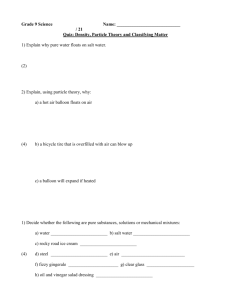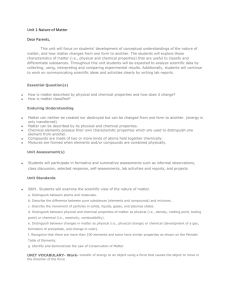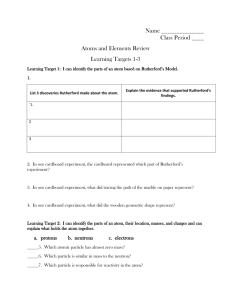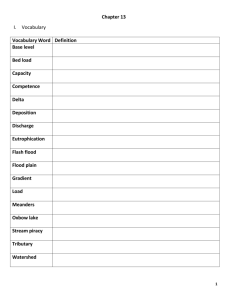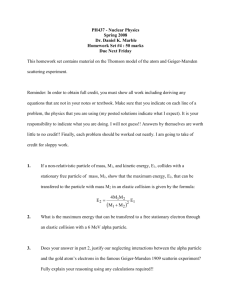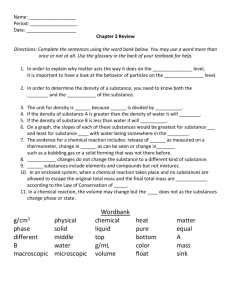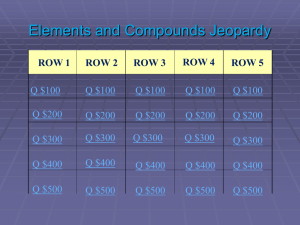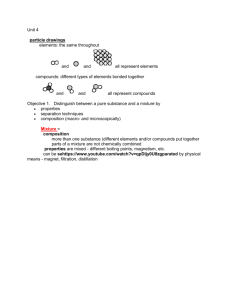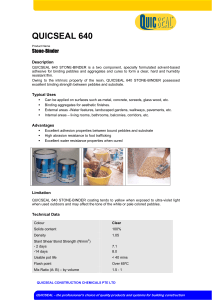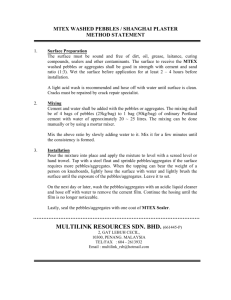Chem Review
advertisement
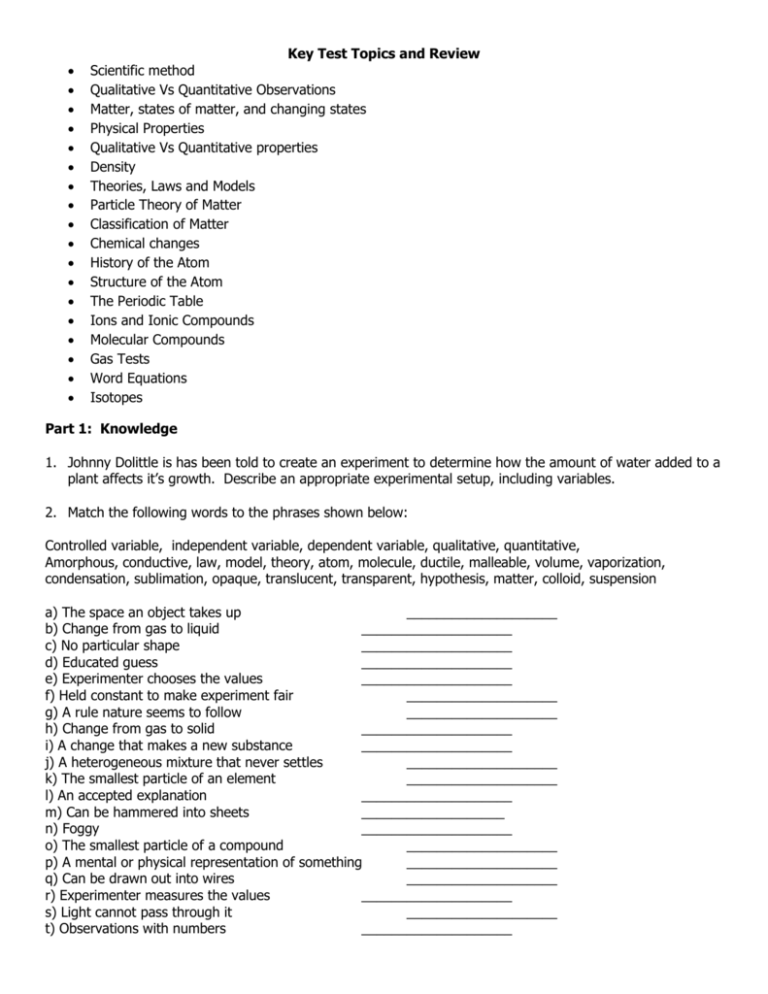
Key Test Topics and Review Scientific method Qualitative Vs Quantitative Observations Matter, states of matter, and changing states Physical Properties Qualitative Vs Quantitative properties Density Theories, Laws and Models Particle Theory of Matter Classification of Matter Chemical changes History of the Atom Structure of the Atom The Periodic Table Ions and Ionic Compounds Molecular Compounds Gas Tests Word Equations Isotopes Part 1: Knowledge 1. Johnny Dolittle is has been told to create an experiment to determine how the amount of water added to a plant affects it’s growth. Describe an appropriate experimental setup, including variables. 2. Match the following words to the phrases shown below: Controlled variable, independent variable, dependent variable, qualitative, quantitative, Amorphous, conductive, law, model, theory, atom, molecule, ductile, malleable, volume, vaporization, condensation, sublimation, opaque, translucent, transparent, hypothesis, matter, colloid, suspension a) The space an object takes up ____________________ b) Change from gas to liquid ____________________ c) No particular shape ____________________ d) Educated guess ____________________ e) Experimenter chooses the values ____________________ f) Held constant to make experiment fair ____________________ g) A rule nature seems to follow ____________________ h) Change from gas to solid ____________________ i) A change that makes a new substance ____________________ j) A heterogeneous mixture that never settles ____________________ k) The smallest particle of an element ____________________ l) An accepted explanation ____________________ m) Can be hammered into sheets ___________________ n) Foggy ____________________ o) The smallest particle of a compound ____________________ p) A mental or physical representation of something ____________________ q) Can be drawn out into wires ____________________ r) Experimenter measures the values ____________________ s) Light cannot pass through it ____________________ t) Observations with numbers ____________________ 1. 2 Describe silver using all appropriate physical properties you can. List one example of each a) Element b) Compound c) ordinary mixture d) solution e) suspension f) colloid of the following ___________________ ___________________ ___________________ ___________________ ___________________ ___________________ 3. What is the particle theory of matter? List its parts. 4. Use the particle theory of matter to explain the changes in state of water from solid to gas. 5. There are many indicators that a chemical change has occurred, but only one definitive proof. Give three examples of indicators and state the only way to be 100% sure that a chemical change has occurred. 6. Explain the difference between a law, theory and model. Part 2: Inquiry 7. Identify each of the following as either a physical or a chemical change. a) toast browning _________ b) hot coil on your stove glowing red ________ c) milk going sour _________ d) clothes drying _________ e) a suspension settling to the bottom _________ 8. John wishes to measure the density of some small gold coloured pebbles in order to determine whether or not they are pure gold. The pebbles have a mass of 136.3 g and when John added the pebbles to 50.0 mL of water in a graduated cylinder, the volume rose to a reading of 64.0 mL. Calculate the density of the pebbles. 9. John did not have pure gold pebbles because pure gold has a density of 19.3 g/cm3. Calculate the volume of 136.3 g of pure gold. Part C: Communication 1. Use the particle theory to answer each of the following: a) Why are gases easy to compress while solids are difficult to compress. ? b) Why is heat needed to vaporize a liquid ? 2. What is a chemical change? Give a simple example 3. J. J. Thomson discovered the _________________. Very briefly describe Thomson’s model of the atom. 4. Rutherford did an experiment that disproved Thomson’s model of the atom. In his experiment Rutherford shot a beam of ___________________ particles at a thin sheet of ____________. Most of these particles ______________________________________ and proved that the atom is mostly ____________________. However, some of the particles bounced back, showing that ___________________. 5. State the names of groups 1,2,17 and 18 on the periodic table. What is similar about the structure of the atoms within each group? 6.Consider potassium. a. number of electrons = ____________ b. number of protons = ____________ c. number of neutrons = ____________ 7. Consider Magnesium. a. atomic number = ____________ b. atomic mass = _____________ 8. Draw the Bohr diagram (showing electron arrangement and number of each particle in the nucleus) for Al . 9. Chlorine is likely to react with sodium but not calcium. Why? Use BR diagrams to explain your answer 10. Use BR diagrams to explain what happens when F reacts with Mg. 14. In a reaction Mg would likely lose 2 electrons to have a stable outer electron structure. So Mg tends to form a Mg2+ ion. What ions would the following elements likely make? K ___________ Al ___________ P ___________ F ___________ 15. Predict the formulas of compounds made by the following pairs of elements. Explain your answer. K and O __________ Be and Cl ____________ B and N ________ 17. Name two example of each of the following: a) Noble Gases ________ b) Alkaline Earth Metals _______ c) Halogens _______ d) Transition Metals ______ 18. Show the bonding in the following compounds using Lewis diagram. a) CF4 b) S2Cl2 18. Look at the classification of matter chart. Explain the difference between pure substances and mixtures. 19. Give an example of each type of mixture and explain the differences between them.
